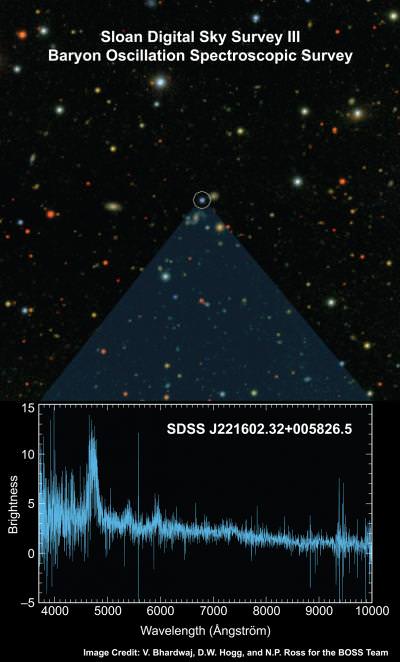[/caption]
Baryon
acoustic oscillation (BAO) sounds like it could be technobabble from a Star Trek episode. BAO is real, but astronomers are searching for these particle fluctuations to do what seems like science fiction: look back in time to find clues about dark energy. The Baryon Oscillation Spectroscopic Survey(BOSS), a part of the Sloan Digital Sky Survey III (SDSS-III), took its "first light" of astronomical data last month, and will map the expansion history of the Universe.
"Baryon oscillation is a fast-maturing method for measuring dark energy in a way that's complementary to the proven techniques of supernova cosmology," said David Schlegel from the Lawrence Berkeley National Laboratory (Berkeley Lab), the Principal Investigator of BOSS. "The data from BOSS will be some of the best ever obtained on the large-scale structure of the Universe."
BOSS uses the same telescope as the original Sloan Digital Sky Survey -- 2.5-meter telescope at Apache Point Observatory in New Mexico -- but equipped with new, specially-built spectrographs to measure the spectra. [caption id="attachment_41890" align="aligncenter" width="386" caption="Senior Operations Engineer Dan Long loads the first cartridge of the night into the Sloan Digital Sky Survey telescope. The cartridge holds a "plug-plate" at the top which then holds a thousand optical fibers shown in red and blue. These cartridges are locked into the base of the telescope and are changed many times during a night. Photo credit: D. Long"]
[/caption] Baryon oscillations began when pressure waves traveled through the early universe. The same density variations left their mark as the Universe evolved, in the periodic clustering of visible matter in galaxies, quasars, and intergalactic gas, as well as in the clumping of invisible dark matter.
Comparing these scales at different eras makes it possible to trace the details of how the Universe has expanded throughout its history – information that can be used to distinguish among competing theories of dark energy.
"Like sound waves passing through air, the waves push some of the matter closer together as they travel" said Nikhil Padmanabhan, a BOSS researcher who recently moved from Berkeley Lab to Yale University. "In the early universe, these waves were moving at half the speed of light, but when the universe was only a few hundred thousand years old, the universe cooled enough to halt the waves, leaving a signature 500 million light-years in length."
"We can see these frozen waves in the distribution of galaxies today," said Daniel Eisenstein of the University of Arizona, the Director of the SDSS-III. "By measuring the length of the baryon oscillations, we can determine how dark energy has affected the expansion history of the universe. That in turn helps us figure out what dark energy could be."
"Studying baryon oscillations is an exciting method for measuring dark energy in a way that's complementary to techniques in supernova cosmology," said Kyle Dawson of the University of Utah, who is leading the commissioning of BOSS. "BOSS's galaxy measurements will be a revolutionary dataset that will provide rich insights into the universe," added Martin White of Berkeley Lab, BOSS's survey scientist.
On Sept. 14-15, 2009, astronomers used BOSS to measure the spectra of a thousand galaxies and quasars. The goal of BOSS is to measure 1.4 million luminous red galaxies at redshifts up to 0.7 (when the Universe was roughly seven billion years old) and 160,000 quasars at redshifts between 2.0 and 3.0 (when the Universe was only about three billion years old). BOSS will also measure variations in the density of hydrogen gas between the galaxies. The observation program will take five years.
Source:
Sloan Digital Sky Survey
 Universe Today
Universe Today
